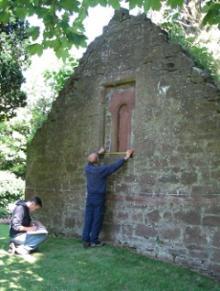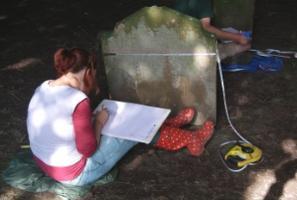Exmagirdle
 Exmagirdle or Ecclesmagirdle church is a ruined single-celled building occupying a small, curvilinear churchyard within the Glenearn Estate. The name of Exmagirdle derives from ecclesia (Latin for ‘church’) and is dedicated to St. Grillán, a companion of St Columba. Both the usage of the ecclesia and the dedication suggests an early ecclesiastical foundation for this chapel, perhaps going back to the 7th or 8th century. In linguistic terms, Exmagirdle is the oldest church in the study area and it is also one of the best documented, having been the object of a dispute between Dunblane Cathedral and Lindores Abbey. It survived as a place of worship until the 18th century although it was incorporated into Dron parish in 1652.
Exmagirdle or Ecclesmagirdle church is a ruined single-celled building occupying a small, curvilinear churchyard within the Glenearn Estate. The name of Exmagirdle derives from ecclesia (Latin for ‘church’) and is dedicated to St. Grillán, a companion of St Columba. Both the usage of the ecclesia and the dedication suggests an early ecclesiastical foundation for this chapel, perhaps going back to the 7th or 8th century. In linguistic terms, Exmagirdle is the oldest church in the study area and it is also one of the best documented, having been the object of a dispute between Dunblane Cathedral and Lindores Abbey. It survived as a place of worship until the 18th century although it was incorporated into Dron parish in 1652.
 Fieldwork here included a measured survey of the church, a topographic survey of the churchyard, documentation of the burial monuments and a geophysical survey of the open areas around the kirkyard. The small, single-celled church retains some medieval architectural features including the east window and an aumbry of 15th-century date or earlier. Although the church has been substantially rebuilt, its proportions - 9.5m by 5.5m- and its setting suggest that it is substantially medieval. Although few in number, there is a fascinating collection of 40 post-medieval burial monuments within the kirkyard providing a unique insight into the composition of rural community of the 17th and 18th centuries and from the mid-19th century, the lairds of Glenearn. These monuments range from elaborate recumbent slabs of the local freeholders to a series of fine headstones erected by farmers and tradesmen, a number of crude stone markers and the finely carved plaques of the modern landowners. Andrew Gourlay was able to identify the majority of those commemorated in local parish records for his MA dissertation (2009).
Fieldwork here included a measured survey of the church, a topographic survey of the churchyard, documentation of the burial monuments and a geophysical survey of the open areas around the kirkyard. The small, single-celled church retains some medieval architectural features including the east window and an aumbry of 15th-century date or earlier. Although the church has been substantially rebuilt, its proportions - 9.5m by 5.5m- and its setting suggest that it is substantially medieval. Although few in number, there is a fascinating collection of 40 post-medieval burial monuments within the kirkyard providing a unique insight into the composition of rural community of the 17th and 18th centuries and from the mid-19th century, the lairds of Glenearn. These monuments range from elaborate recumbent slabs of the local freeholders to a series of fine headstones erected by farmers and tradesmen, a number of crude stone markers and the finely carved plaques of the modern landowners. Andrew Gourlay was able to identify the majority of those commemorated in local parish records for his MA dissertation (2009).
On the south and east sides of the curving kirkyard the boundary appears to follow an ancient line, although the wall itself has been heavily rebuilt. To the north and west the churchyard had been truncated in post-medieval times to accommodate developments in the farm layout.



